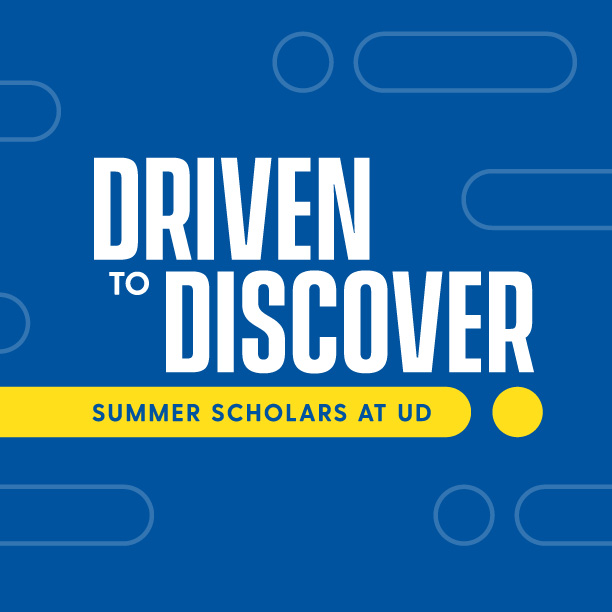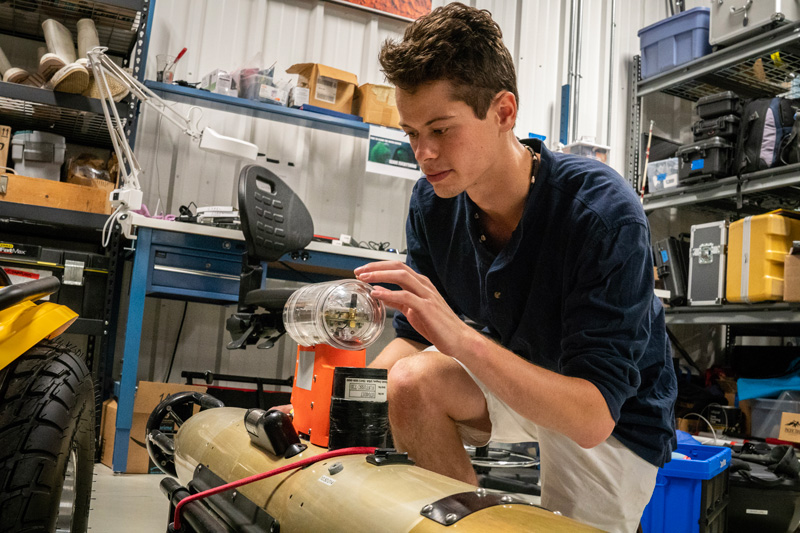

Hide and seek with scallops
Photo by Michael Graw August 10, 2018
Conner McCrone uses data science to find marine organisms on the seafloor
Editor’s Note: Get to know a dozen of our 2018 undergraduate Summer Scholars in this series of question/answer profiles on them and their work. The Summer Scholars program offers undergrads an expansive menu of research and service opportunities from the streets to the field to the laboratory. A record number of students - more than 530 - participated this summer. It’s a mark of distinction for UD, according to Associate Prof. Iain Crawford, faculty director of UD’s Undergraduate Research Program and president of the national Council on Undergraduate Research: “We have that culture firmly established at Delaware, where the value of undergraduate research is strongly felt.” To learn about the work of some of this year's Summer Scholars, visit https://www.udel.edu/home/summer-undergrad-research/.
Conner McCrone is a senior, majoring in marine science, from Nazareth, Pennsylvania.
Q: What is your research focus at UD?
McCrone: I am studying seascapes and their effectiveness at detecting the presence of benthic organisms that live in and on the seafloor, such as scallops. Seascapes are computer models that try to determine where the organisms are most likely to be found based on parameters that the scallops prefer, such as ideal temperature, substrate or saltiness of the seawater. Scallop fisheries would be able to use this seascape data to better predict where scallops would be congregated without the use of expensive habitat mapping camera technology.

Q: What interest you most about this?
McCrone: To me, it's super cool that we can find out where these organisms are located based on oceanographic parameters like temperature or water salinity, or just by features on the seafloor. It's important from both a conservation perspective and a sustainability standpoint.
Q: What is a typical day like?
McCrone: For my specific project, I am working with Art Trembanis, an associate professor in the College of Earth, Ocean, and Environment’s School of Marine Science and Policy. The data I’m using has already been collected, so I usually do data analysis or assist other interns or graduate students with their field work if they need help. The sonar used in my research was side-scan sonar, which paints a picture of the seafloor called a mosaic. I can export this mosaic data into a mapping and geographic information system, called GIS, in order to identify the different substrate types surrounding the scallops and to help see what type the scallops prefer. Then, I use other software and statistical analysis programs to analyze data that has been collected and create my seascape model.
Q: What is the coolest thing you’ve gotten to do on the project?
McCrone: The coolest thing I've gotten to do is test a new type of sonar by mapping a shipwreck in the Delaware Bay with Carter Duval, a doctoral student in Dr. Trembanis’ lab. This involved us going out to sea for most of the day on one of UD’s research vessels, the R/V Joanne Daiber.
Q: What has surprised you the most about your experience?
McCrone: I was surprised by the amount of coding and computer knowledge that accompanies scientific work. Field work is super fun, but it doesn't matter if you don't know how to analyze the data that you collect.
Q: Dreaming big, where do you hope this work could lead?
McCrone: I hope that any model I produce can help create seascape models for other larger benthic organisms, such as rays. Having a seascape model for rays would be helpful for conservation techniques and also useful for management of dredge fishing techniques, since it would allow fishing boats to avoid dredging in areas where larger benthic animals may be living.
Q: If you had to summarize your experience in only one word, what would it be?
McCrone: Interesting
Q: What do you enjoy when you are not doing research?
McCrone: I like to build novelty fish tanks. So far, I've made one out of a lava lamp and another one out of an old TV.
Contact Us
Have a UDaily story idea?
Contact us at ocm@udel.edu
Members of the press
Contact us at 302-831-NEWS or visit the Media Relations website


